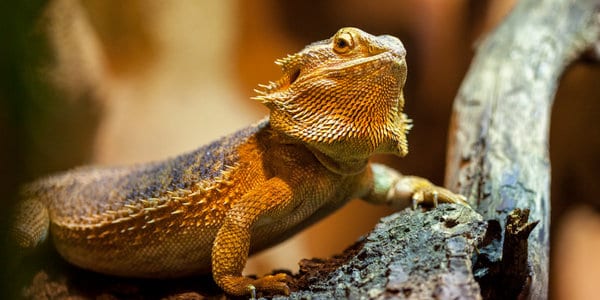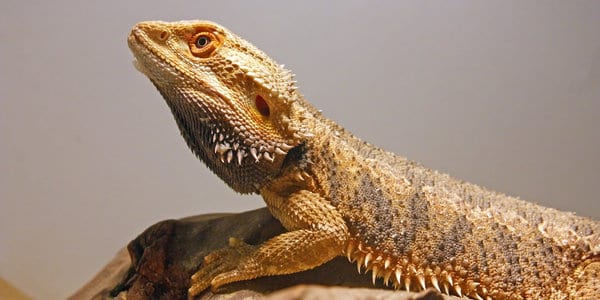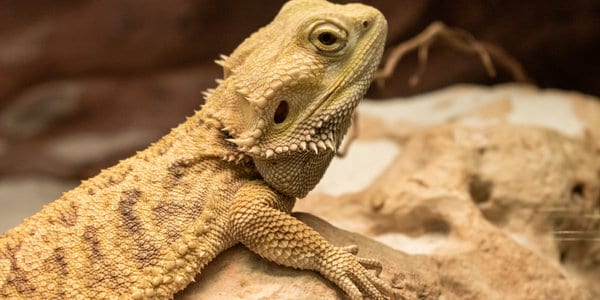Some bearded dragon owners may be worried or disappointed if their bearded dragon isn’t growing as fast as they’re supposed to.
If you’re worried about your beardie’s growth, it’s best to ensure some factors are in place so your pet can grow optimally.
1. Provide the Ideal Environment
Your bearded dragon will achieve its expected growth milestones if you provide a conducive environment. Since beardies are territorial, it’s best not to keep two of them in a cage. Moreover, dragons have specific housing requirements, which include the following:
Spacious enclosure
Bearded dragon grow optimally in glass tank size measuring 48 X 28 X 18 inches (121.9×71.1×45.7 centimeters). Furthermore, the enclosure should be well ventilated and easy to disinfect.
Proper lighting and heating
Bearded dragons require ultraviolet B (UVB light) for healthy growth and development. Although your bearded dragon can obtain this light from the sun, you can provide UVB lighting by fitting a fluorescent bulb in the enclosure. Also include a 40 -75W infrared basking bulb, and a shade for cooling.
Proper humidity
Bearded dragons prefer moderate humidity (40 – 60% relative humidity) for comfort and to facilitate growth.
Right temperature
Bearded dragons thrive in warm climates in the wild and are diurnal (active in the daytime). So, it’s best to create an environment where tank temperature are about 80°F – 85°F (26.7 – 29.4°C) during the day and 70°F – 75°F (21.1 – 23.8°C) at night.
A suitable substrate
The best substrates (base) for a bearded dragon’s enclosure are paper towels or newspapers since they’re safe for contact and easy to dispose of.
2. Provide a Wholesome Diet
Bearded dragon require a well-balanced healthy diet, including plenty of protein and plant matter. Additionally, it’s advisable to include calcium supplement and multivitamin (such as vitamin d) for skeletal development and healthy metabolism.
Occasionally, you can let your pet have some treats, like fruits or specific flowers.
It’s best to feed your bearded dragon in the morning so they have ample time to digest their food through the day.
It’s also essential to keep your bearded dragon properly hydrated. However, these lizards don’t like drinking water from deep bowls.
So it’s best to provide clean water every day in a shallow bowl and mist their enclosures regularly to keep them cool.

3. Handle Them With Care
Bearded dragons have few grooming requirements, and you won’t be required to bathe your pet regularly or clean their fur. However, it’s crucial to handle them properly when you’re interacting with them while feeding or misting.
Proper handling is crucial for their growth and development. Experts acknowledge that bearded dragons can develop stress, anxiety, or agitation if you handle them roughly or in a strange manner. The worry and stress can negatively impact their rate of growth and development.
Although bearded dragons are docile and friendly towards humans anyway, proper handling will also help protect you from their rough and spiky bodies.
So, when handling your Bearded dragon:
- Allow them to get familiar with your presence before you touch or pick them up.
- Clean your hands before holding them and wear light gloves.
- Keep their toenails short to avoid scratches.
- Avoid holding them by the tail as they can break easily (and they do not regenerate).
4. Consult a Vet
Even if you’re doing everything correctly, chances are your bearded dragon isn’t growing optimally. In such cases it’s possible that your pet is suffering from some disease, and it’s best to consult a vet to diagnose the problem.
You can seek a vet’s advice if your bearded dragon:
- Appears sluggish or lethargic all the time
- Seems overweight or obese
- Is excessively aggressive
- Suddenly loses its appetite
How Fast Do Bearded Dragons Grow?
Bearded dragons grow between one and three inches (2.5 – 7.5cm) every month when they’re babies. Various factors affect their growth rate, including genetic makeup, environment, diet, and sex. By adulthood, most bearded dragons are between fifteen and twenty inches (38 – 50cm) long.
What is the Average Size of a Bearded Dragon after Hatching?
Bearded dragons lay eggs that hatch and bring new beardies into this world. Female dragons can even store sperms after mating, and tend to lay eggs multiple times after a single mating season. The eggs hatch in seventy to eighty days when incubated at 28–30°C (82–86°F).
After hatching, the average size of bearded dragons is 3.5 inches (8.9 cm). While they’re tiny at first, the hatchlings have an accelerated growth rate in the first two months and can gain between two and four inches (5.1 – 10.2cm) in just two to six months.
By knowing the average bearded dragon growth rate of different ages you can figure out if your spiky friend is growing properly.
For instance, hatchlings grow at 1 to 1.5 inches (2.5 to 3.8 cm) per week, while juvenile bearded dragons (between two and seven months) grow between one and three inches (2.5 – 7.6 cm) every month.
The process slows down when the dragons attain sexual maturity, and they’ve usually achieved their maximum body size when they’re about twelve to eighteen months of age.
Since hatchlings and juvenile bearded dragons grow significantly fast, they also shed their coats quickly. Hence, you may notice one or sometimes two shedding’s a month.
However, despite their rapid growth rate, baby bearded dragons can be stunted due to infections or poor quality of life.
You can roughly calculate how big your pet bearded dragon will get by using their age and growth rate as metrics.
For instance, after hatching a baby beardie will be between three to four inches (7.6 – 10.2cm) long, and will grow about six inches (15.2 – 22.9cm) long after a week. So, by estimation, you can say that their next growth spurt will place them at double the size.
Beardies also gain weight as the length of their body increases. Hatchlings are approximately four grams (0.14 ounces) at ‘birth’ and can accumulate up to thirty-five grams (1.2 ounces) in a month or two.
If you’re a new pet owner, your bearded dragon’s size can help you guess their age. But it’s impossible to guess if you aren’t aware of the average size of a bearded dragon at different ages.
So here’s a chart showing you the approximate dimensions of bearded dragons according to their age.
| Age (Months) | Body Length | Weight (Grams) |
| 0-1 | 3 – 4 inches (7.6 – 10.2cm) | 4 – 6 |
| 2 | 5 – 9 inches (12.7 – 22.9cm) | 8 – 40 |
| 3 | 8 -11 inches (20.3 – 27.9CM) | 22 – 110 |
| 4 | 9 – 12 inches (22.9 – 30.5cm) | 41 – 115 |
| 5 | 11 -16 inches (20.3 – 40.6cm) | 102 – 115 |
| 6 | 11 – 18 inches (20.3 – 45.7cm) | 183 – 188 |
| 7 | 13 – 18 inches (33.02 – 45.7cm) | 230 – 280 |
| 8 | 14 – 20 inches (33.0 – 50.8cm) | 252 – 327 |
| 9-10 | 16 – 22 inches (40.6 – 55.9cm) | 280 – 360 |
| 11-12 | 16 – 24 inches (40.6 – 60.9cm) | 350 – 465 |
| 12+ | 24 inches (60.9cm) | 380 – 510 |

What Factors Influence the Growth Rate of Bearded Dragons?
Although bearded dragons have accelerated growth as hatchlings and juveniles, not all beardies grow the same way.
If your spiky friend isn’t growing according to the average lengths and weights mentioned on the chart, some other factors may be at play. If this is the case, it’s best to consult a vet and diagnose the problem.
Factors that influence the growth rate of bearded dragons include genetic makeup, age, environment, and health. The speed at which your bearded dragon grows also depends on what you’re feeding it. Additionally, gender plays a significant role in how big a bearded dragon can get.
Let’s take a look at some of these factors.
1. Genetic Makeup
Like humans, bearded dragons have varying genetic dispositions based on their parents (and ancestors). Therefore, the growth rate will vary among different Pogona species. For example, the Pogona Microlepidota are the smallest bearded dragons, growing roughly four to six inches (10.2 – 15.2cm) in size.
On the other hand, the largest species are the Pogona Barbata (Eastern/Coastal Bearded Dragons) and the Pogona Vitticeps (Central Bearded Dragon). These two types of lizards can grow up to twenty-four inches (60.8cm) by the time they reach sexual maturity.
So when you adopt a bearded dragon, it’s best to find out what species they belong to so you can predict how big they’ll be at a certain age.
Here’s a chart showing the adult body sizes and weights of the eight different species of bearded dragon:
| Pogona Species | Body Length (Inches) | Weight (grams) |
| Pogona microlepidota | 4 – 6 | 6 – 40 |
| Pogona henrylawsoni | 9 – 12 | 50 – 200 |
| Pogona minor mina | 10 – 12 | 100 – 200 |
| Pogona nullarbor | 12 – 14 | 200 – 250 |
| Pogona minor | 14 – 18 | 250 – 450 |
| Pogona minor mitchelli | 16 – 18 | 380 – 450 |
| Pogona vitticeps | 16 – 24 | 380 – 510 |
| Pogona barbata | 20 – 24 | 400 – 510 |
2. Age
A bearded dragon’s growth rate changes with age. As we’ve already mentioned, baby beardies grow faster than adults, and before they’re even a year old these babies will grow roughly one to three inches every month.
However, right after the 12-month mark, their growth rate decreases significantly. And once they reach sexual maturity, bearded dragons stop growing altogether.
Therefore, you can roughly predict your Beardie’s maximum body length when they’re around twelve to eighteen months old.
3. Environment
The environment in which a bearded dragon lives significantly influences its rate of growth. As such, the lack of a proper home can lead to stress and stunt the growth of bearded dragons.
In the wild, bearded dragon prefer warm (or arid) climates, like deserts, woodlands, and shrublands. They’re pretty active during the day and love basking in the sun, on branches and rocks, or hanging around human settlements.
In captivity, bearded dragons thrive in spacious glass enclosures fitted with UVB lighting and infrared heat (for basking).
Therefore, a small, poorly lit enclosure can lead to stunted growth as your pet isn’t receiving ideal conditions for its growth and development.
Aside from installing artificial lighting in the enclosure, it’s best to let your pet dragon bask in natural sunlight from time to time when possible.
Additionally, bearded dragons prefer moderate humidity and it’s best to ensure that their enclosure has about 40% – 60% relative humidity.
4. Diet and Health
Your bearded dragon will experience optimal growth if they are fed the proper diet. Adult bearded dragons need about 70% plant matter and 30% protein.
On the other hand, baby bearded dragons require more protein than plant matter as they experience explosive growth spurts.
A wrongly balanced diet will impede a beardie’s growth, especially if they’re in the infant and juvenile stages. For instance, feeding them less protein during their growth spurts can significantly reduce the rate at which their bodies lengthen.
You also want to be careful to avoid a high-fat, protein diet and dehydration due to insufficient water as these can lead to nutrition disorders.
Bearded dragons may also fail to eat properly due to territorial issues. These lizards adhere to dominance cues, and it’s best to keep them in a cage alone without competition as one dragon will tend to eat less in such a situation.
Poor health can also stunt growth in bearded dragons. While they’re hardy lizards, improper diets and poor environments can cause disease.
The most common illnesses in bearded dragons include metabolic bone disease, respiratory infections, parasitic infections, ‘mouth rot,’ and adenovirus infection.
5. Sex
Male and female bearded dragons exhibit obvious physical differences (sexual dimorphism). For instance, they differ in the number of bumps under their tails and their head sizes.
Aside from these physical differences, gender also plays a significant role in growth rate. The maximum body length for female beardies is usually twenty inches (50.8cm). On the other hand, male bearded dragons can grow up to twenty-four inches (60.9cm).

How Big Can a Bearded Dragon Get?
A bearded dragon can grow up to eighteen to twenty-four inches (45.7 – 60.9cm) when they are well-fed and in a spacious enclosure. Their maximum body size will vary though, and some breeders can even alter their genetic makeup, breeding dragons greater than twenty-four inches in length.
For instance, the German Giant morph is a rare bearded dragon breed that grows to a whopping thirty-two inches (81.3cm)! Additionally, the size of German Giant babies (up to six months) ranges from three to twenty-one inches (7.6 – 53.3cm)!
On average though, the length of an adult size bearded dragon is the same as the size of their tails. They attain their maximum length at around twelve months of age, when they reach adulthood.
As mentioned earlier though, the length of a bearded dragon will differ based on the species it belongs to. Furthermore, poor environmental conditions can lead to stunted growth and development.
Final Words
Bearded dragons are friendly, fast-growing pet reptiles that thrive in an ideal environment. And while it can be challenging to create the ideal environment and feed them properly, it’s only a matter of time before you get used to it.
And these scaly pets can be a pleasure to have around once you get used to their presence.